Managing Projects for Innovation: Coursework Report
VerifiedAdded on 2022/09/30
|17
|4480
|8
Report
AI Summary
This report, focused on "Managing Projects for Innovation," delves into the critical role of innovation within project management, particularly in the construction sector. It begins with an executive summary highlighting the importance of innovation for economic growth and quality of life, emphasizing the significance of both internal and external stakeholders. The report undertakes a literature review, critically analyzing internal and external drivers of innovation, such as manufacturing firms, consumers, industry relationships, procurement systems, and organizational resources. It then examines conceptual models for the effective diffusion of innovation, with a specific focus on the construction industry. The report highlights the unique challenges of innovation in construction compared to manufacturing. The analysis then extends to two case studies: the development of a thermal conversion unit to remove coal tar from recycled asphalt and the development of a sprayable waterproofing membrane for tunneling, illustrating how innovation ideas are diffused and their impact. The report also discusses the importance of project managers ensuring their teams deliver innovation through effective diffusion. The research effort focuses on the student's organization, providing a detailed framework for the research needed for the report.
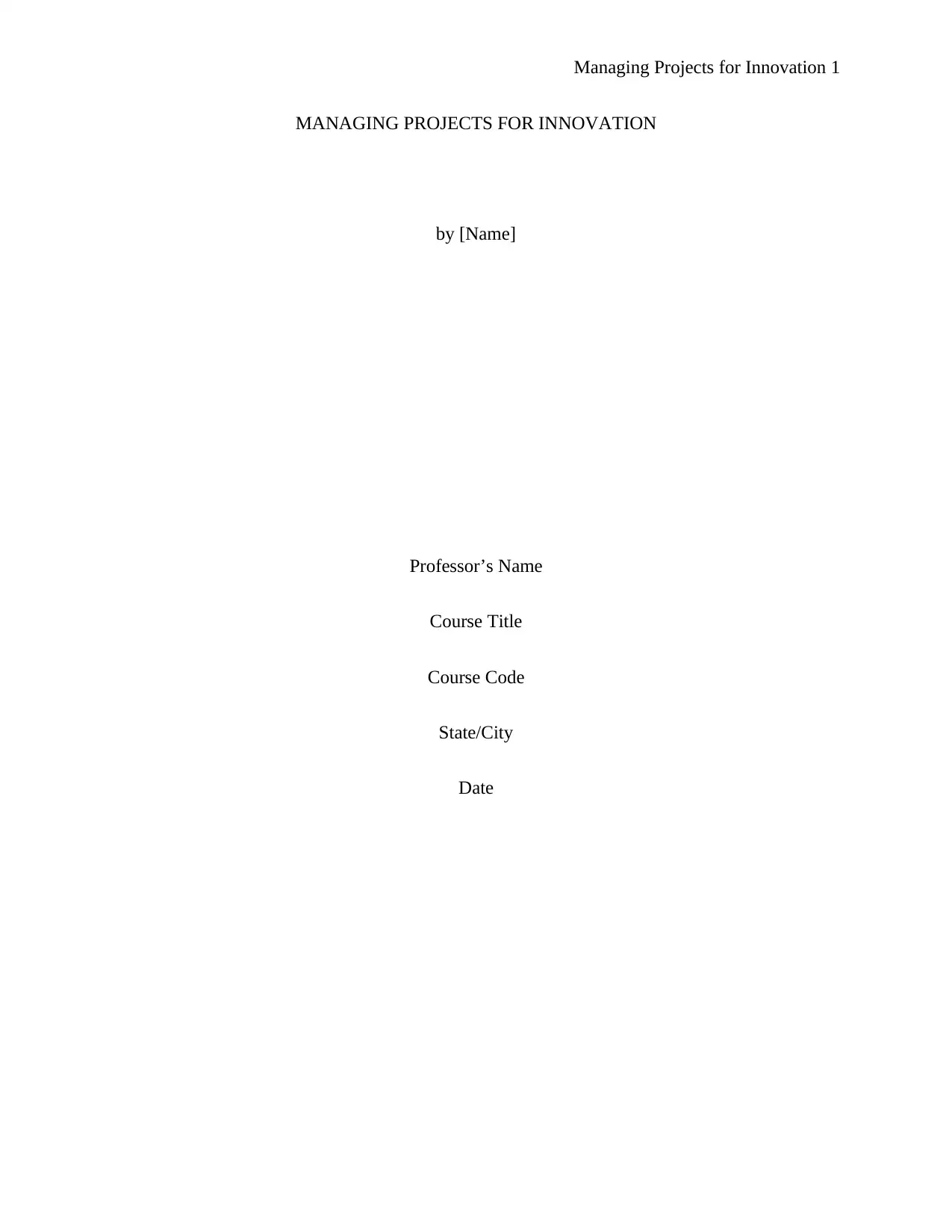
Managing Projects for Innovation 1
MANAGING PROJECTS FOR INNOVATION
by [Name]
Professor’s Name
Course Title
Course Code
State/City
Date
MANAGING PROJECTS FOR INNOVATION
by [Name]
Professor’s Name
Course Title
Course Code
State/City
Date
Secure Best Marks with AI Grader
Need help grading? Try our AI Grader for instant feedback on your assignments.
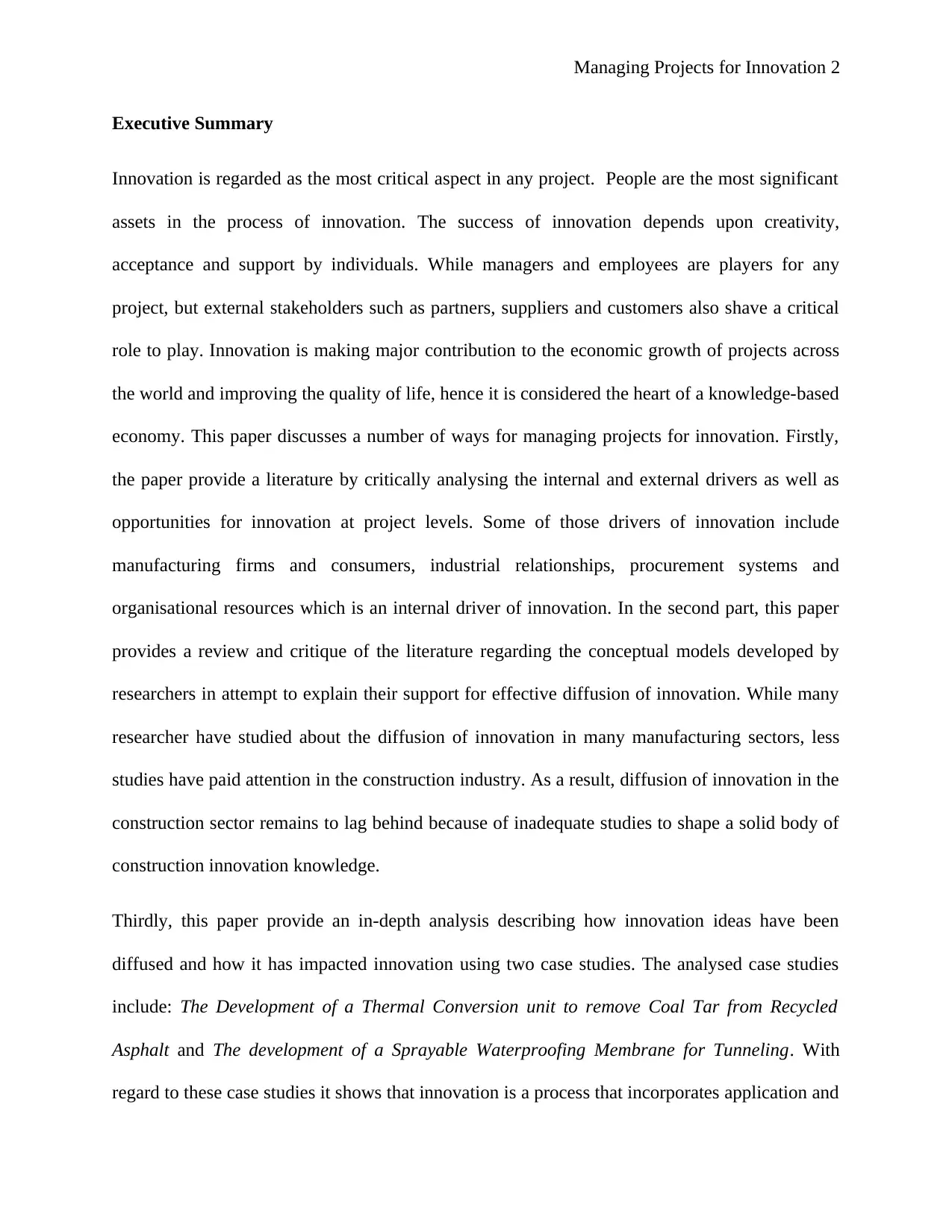
Managing Projects for Innovation 2
Executive Summary
Innovation is regarded as the most critical aspect in any project. People are the most significant
assets in the process of innovation. The success of innovation depends upon creativity,
acceptance and support by individuals. While managers and employees are players for any
project, but external stakeholders such as partners, suppliers and customers also shave a critical
role to play. Innovation is making major contribution to the economic growth of projects across
the world and improving the quality of life, hence it is considered the heart of a knowledge-based
economy. This paper discusses a number of ways for managing projects for innovation. Firstly,
the paper provide a literature by critically analysing the internal and external drivers as well as
opportunities for innovation at project levels. Some of those drivers of innovation include
manufacturing firms and consumers, industrial relationships, procurement systems and
organisational resources which is an internal driver of innovation. In the second part, this paper
provides a review and critique of the literature regarding the conceptual models developed by
researchers in attempt to explain their support for effective diffusion of innovation. While many
researcher have studied about the diffusion of innovation in many manufacturing sectors, less
studies have paid attention in the construction industry. As a result, diffusion of innovation in the
construction sector remains to lag behind because of inadequate studies to shape a solid body of
construction innovation knowledge.
Thirdly, this paper provide an in-depth analysis describing how innovation ideas have been
diffused and how it has impacted innovation using two case studies. The analysed case studies
include: The Development of a Thermal Conversion unit to remove Coal Tar from Recycled
Asphalt and The development of a Sprayable Waterproofing Membrane for Tunneling. With
regard to these case studies it shows that innovation is a process that incorporates application and
Executive Summary
Innovation is regarded as the most critical aspect in any project. People are the most significant
assets in the process of innovation. The success of innovation depends upon creativity,
acceptance and support by individuals. While managers and employees are players for any
project, but external stakeholders such as partners, suppliers and customers also shave a critical
role to play. Innovation is making major contribution to the economic growth of projects across
the world and improving the quality of life, hence it is considered the heart of a knowledge-based
economy. This paper discusses a number of ways for managing projects for innovation. Firstly,
the paper provide a literature by critically analysing the internal and external drivers as well as
opportunities for innovation at project levels. Some of those drivers of innovation include
manufacturing firms and consumers, industrial relationships, procurement systems and
organisational resources which is an internal driver of innovation. In the second part, this paper
provides a review and critique of the literature regarding the conceptual models developed by
researchers in attempt to explain their support for effective diffusion of innovation. While many
researcher have studied about the diffusion of innovation in many manufacturing sectors, less
studies have paid attention in the construction industry. As a result, diffusion of innovation in the
construction sector remains to lag behind because of inadequate studies to shape a solid body of
construction innovation knowledge.
Thirdly, this paper provide an in-depth analysis describing how innovation ideas have been
diffused and how it has impacted innovation using two case studies. The analysed case studies
include: The Development of a Thermal Conversion unit to remove Coal Tar from Recycled
Asphalt and The development of a Sprayable Waterproofing Membrane for Tunneling. With
regard to these case studies it shows that innovation is a process that incorporates application and
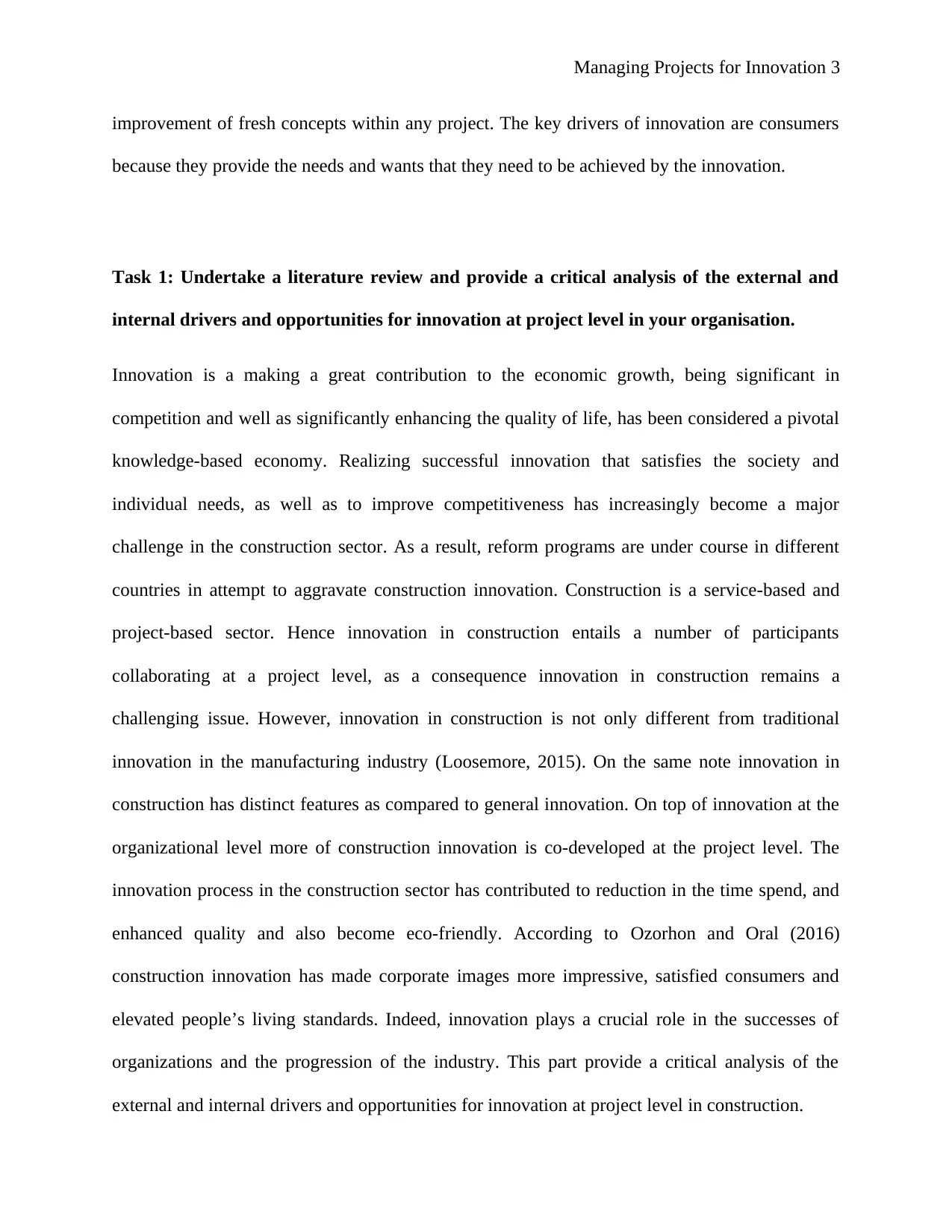
Managing Projects for Innovation 3
improvement of fresh concepts within any project. The key drivers of innovation are consumers
because they provide the needs and wants that they need to be achieved by the innovation.
Task 1: Undertake a literature review and provide a critical analysis of the external and
internal drivers and opportunities for innovation at project level in your organisation.
Innovation is a making a great contribution to the economic growth, being significant in
competition and well as significantly enhancing the quality of life, has been considered a pivotal
knowledge-based economy. Realizing successful innovation that satisfies the society and
individual needs, as well as to improve competitiveness has increasingly become a major
challenge in the construction sector. As a result, reform programs are under course in different
countries in attempt to aggravate construction innovation. Construction is a service-based and
project-based sector. Hence innovation in construction entails a number of participants
collaborating at a project level, as a consequence innovation in construction remains a
challenging issue. However, innovation in construction is not only different from traditional
innovation in the manufacturing industry (Loosemore, 2015). On the same note innovation in
construction has distinct features as compared to general innovation. On top of innovation at the
organizational level more of construction innovation is co-developed at the project level. The
innovation process in the construction sector has contributed to reduction in the time spend, and
enhanced quality and also become eco-friendly. According to Ozorhon and Oral (2016)
construction innovation has made corporate images more impressive, satisfied consumers and
elevated people’s living standards. Indeed, innovation plays a crucial role in the successes of
organizations and the progression of the industry. This part provide a critical analysis of the
external and internal drivers and opportunities for innovation at project level in construction.
improvement of fresh concepts within any project. The key drivers of innovation are consumers
because they provide the needs and wants that they need to be achieved by the innovation.
Task 1: Undertake a literature review and provide a critical analysis of the external and
internal drivers and opportunities for innovation at project level in your organisation.
Innovation is a making a great contribution to the economic growth, being significant in
competition and well as significantly enhancing the quality of life, has been considered a pivotal
knowledge-based economy. Realizing successful innovation that satisfies the society and
individual needs, as well as to improve competitiveness has increasingly become a major
challenge in the construction sector. As a result, reform programs are under course in different
countries in attempt to aggravate construction innovation. Construction is a service-based and
project-based sector. Hence innovation in construction entails a number of participants
collaborating at a project level, as a consequence innovation in construction remains a
challenging issue. However, innovation in construction is not only different from traditional
innovation in the manufacturing industry (Loosemore, 2015). On the same note innovation in
construction has distinct features as compared to general innovation. On top of innovation at the
organizational level more of construction innovation is co-developed at the project level. The
innovation process in the construction sector has contributed to reduction in the time spend, and
enhanced quality and also become eco-friendly. According to Ozorhon and Oral (2016)
construction innovation has made corporate images more impressive, satisfied consumers and
elevated people’s living standards. Indeed, innovation plays a crucial role in the successes of
organizations and the progression of the industry. This part provide a critical analysis of the
external and internal drivers and opportunities for innovation at project level in construction.
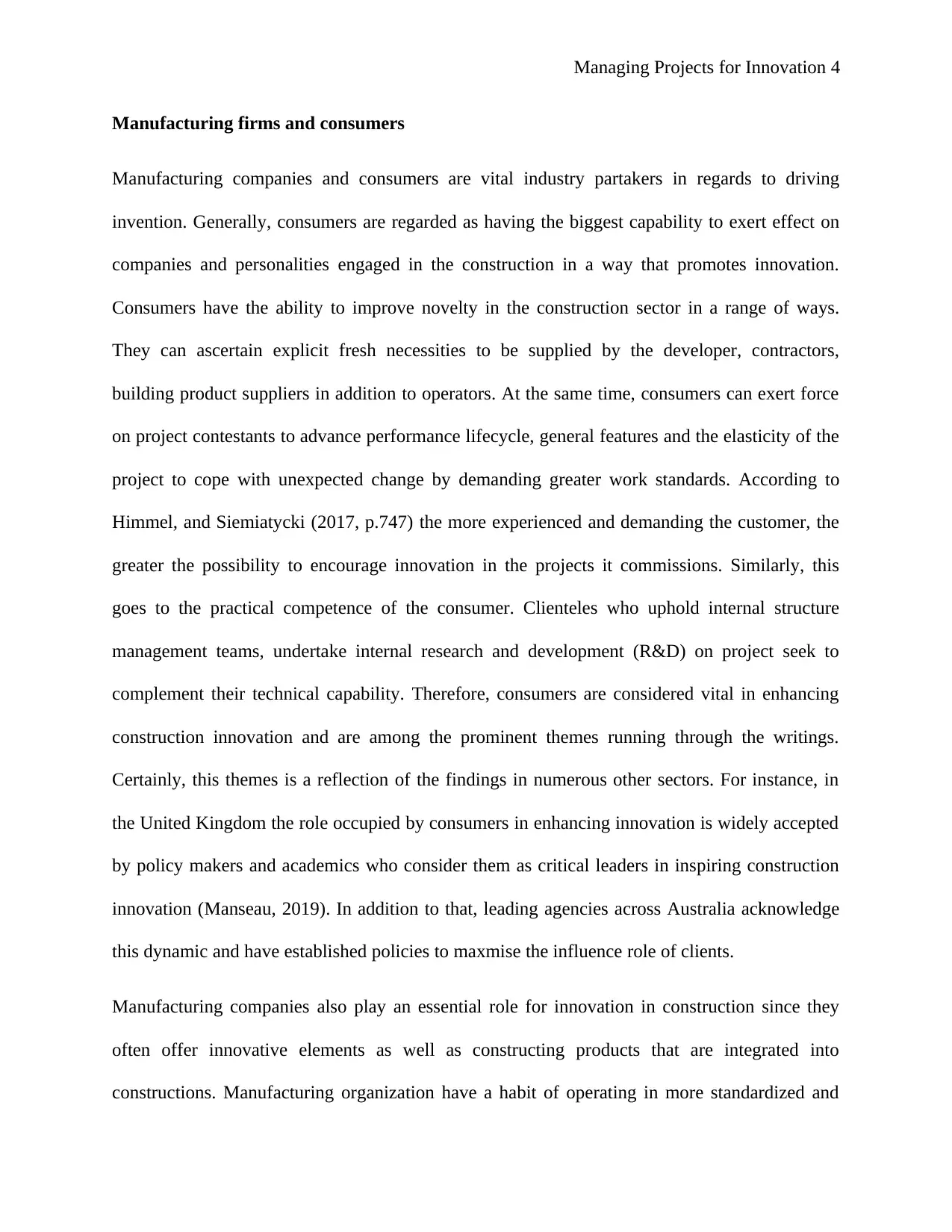
Managing Projects for Innovation 4
Manufacturing firms and consumers
Manufacturing companies and consumers are vital industry partakers in regards to driving
invention. Generally, consumers are regarded as having the biggest capability to exert effect on
companies and personalities engaged in the construction in a way that promotes innovation.
Consumers have the ability to improve novelty in the construction sector in a range of ways.
They can ascertain explicit fresh necessities to be supplied by the developer, contractors,
building product suppliers in addition to operators. At the same time, consumers can exert force
on project contestants to advance performance lifecycle, general features and the elasticity of the
project to cope with unexpected change by demanding greater work standards. According to
Himmel, and Siemiatycki (2017, p.747) the more experienced and demanding the customer, the
greater the possibility to encourage innovation in the projects it commissions. Similarly, this
goes to the practical competence of the consumer. Clienteles who uphold internal structure
management teams, undertake internal research and development (R&D) on project seek to
complement their technical capability. Therefore, consumers are considered vital in enhancing
construction innovation and are among the prominent themes running through the writings.
Certainly, this themes is a reflection of the findings in numerous other sectors. For instance, in
the United Kingdom the role occupied by consumers in enhancing innovation is widely accepted
by policy makers and academics who consider them as critical leaders in inspiring construction
innovation (Manseau, 2019). In addition to that, leading agencies across Australia acknowledge
this dynamic and have established policies to maxmise the influence role of clients.
Manufacturing companies also play an essential role for innovation in construction since they
often offer innovative elements as well as constructing products that are integrated into
constructions. Manufacturing organization have a habit of operating in more standardized and
Manufacturing firms and consumers
Manufacturing companies and consumers are vital industry partakers in regards to driving
invention. Generally, consumers are regarded as having the biggest capability to exert effect on
companies and personalities engaged in the construction in a way that promotes innovation.
Consumers have the ability to improve novelty in the construction sector in a range of ways.
They can ascertain explicit fresh necessities to be supplied by the developer, contractors,
building product suppliers in addition to operators. At the same time, consumers can exert force
on project contestants to advance performance lifecycle, general features and the elasticity of the
project to cope with unexpected change by demanding greater work standards. According to
Himmel, and Siemiatycki (2017, p.747) the more experienced and demanding the customer, the
greater the possibility to encourage innovation in the projects it commissions. Similarly, this
goes to the practical competence of the consumer. Clienteles who uphold internal structure
management teams, undertake internal research and development (R&D) on project seek to
complement their technical capability. Therefore, consumers are considered vital in enhancing
construction innovation and are among the prominent themes running through the writings.
Certainly, this themes is a reflection of the findings in numerous other sectors. For instance, in
the United Kingdom the role occupied by consumers in enhancing innovation is widely accepted
by policy makers and academics who consider them as critical leaders in inspiring construction
innovation (Manseau, 2019). In addition to that, leading agencies across Australia acknowledge
this dynamic and have established policies to maxmise the influence role of clients.
Manufacturing companies also play an essential role for innovation in construction since they
often offer innovative elements as well as constructing products that are integrated into
constructions. Manufacturing organization have a habit of operating in more standardized and
Secure Best Marks with AI Grader
Need help grading? Try our AI Grader for instant feedback on your assignments.
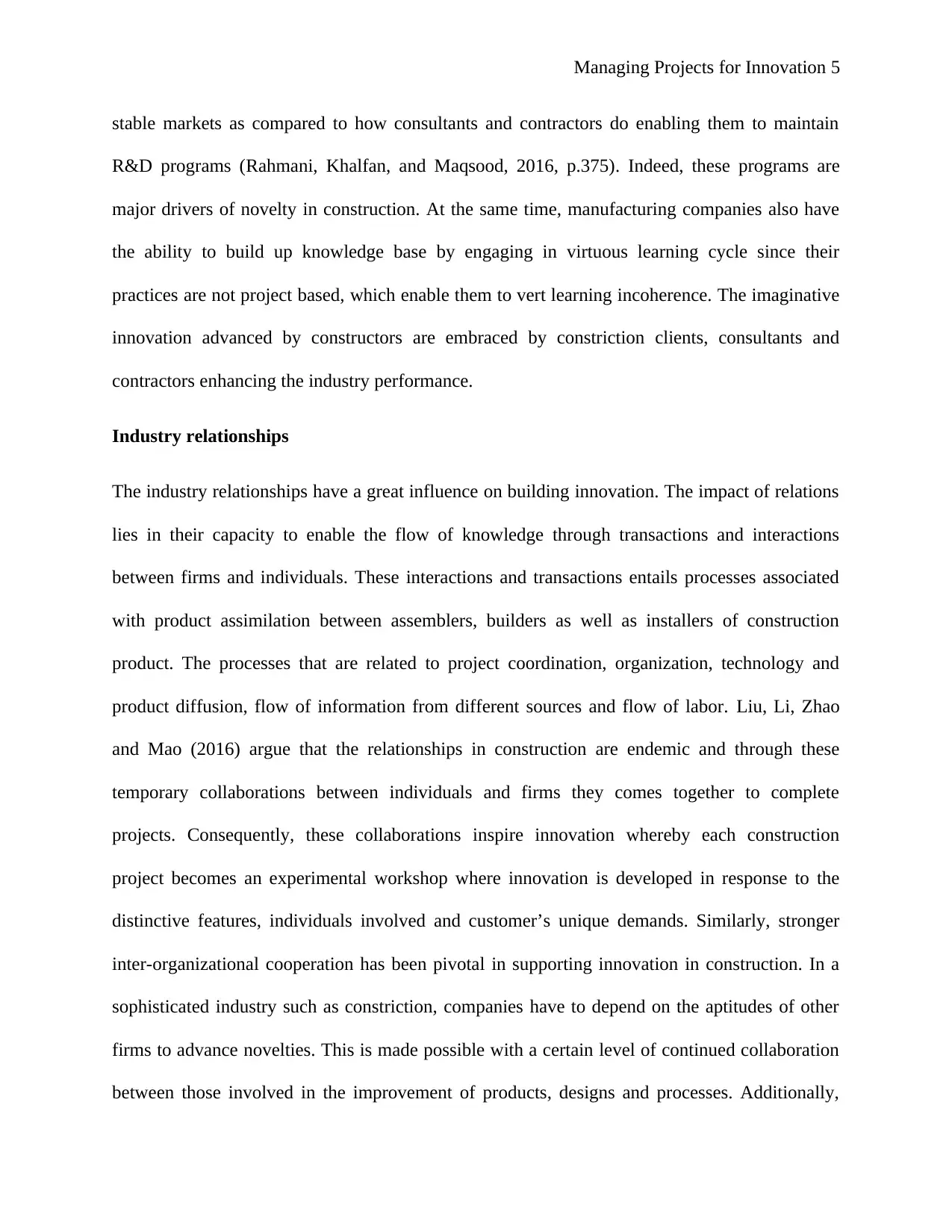
Managing Projects for Innovation 5
stable markets as compared to how consultants and contractors do enabling them to maintain
R&D programs (Rahmani, Khalfan, and Maqsood, 2016, p.375). Indeed, these programs are
major drivers of novelty in construction. At the same time, manufacturing companies also have
the ability to build up knowledge base by engaging in virtuous learning cycle since their
practices are not project based, which enable them to vert learning incoherence. The imaginative
innovation advanced by constructors are embraced by constriction clients, consultants and
contractors enhancing the industry performance.
Industry relationships
The industry relationships have a great influence on building innovation. The impact of relations
lies in their capacity to enable the flow of knowledge through transactions and interactions
between firms and individuals. These interactions and transactions entails processes associated
with product assimilation between assemblers, builders as well as installers of construction
product. The processes that are related to project coordination, organization, technology and
product diffusion, flow of information from different sources and flow of labor. Liu, Li, Zhao
and Mao (2016) argue that the relationships in construction are endemic and through these
temporary collaborations between individuals and firms they comes together to complete
projects. Consequently, these collaborations inspire innovation whereby each construction
project becomes an experimental workshop where innovation is developed in response to the
distinctive features, individuals involved and customer’s unique demands. Similarly, stronger
inter-organizational cooperation has been pivotal in supporting innovation in construction. In a
sophisticated industry such as constriction, companies have to depend on the aptitudes of other
firms to advance novelties. This is made possible with a certain level of continued collaboration
between those involved in the improvement of products, designs and processes. Additionally,
stable markets as compared to how consultants and contractors do enabling them to maintain
R&D programs (Rahmani, Khalfan, and Maqsood, 2016, p.375). Indeed, these programs are
major drivers of novelty in construction. At the same time, manufacturing companies also have
the ability to build up knowledge base by engaging in virtuous learning cycle since their
practices are not project based, which enable them to vert learning incoherence. The imaginative
innovation advanced by constructors are embraced by constriction clients, consultants and
contractors enhancing the industry performance.
Industry relationships
The industry relationships have a great influence on building innovation. The impact of relations
lies in their capacity to enable the flow of knowledge through transactions and interactions
between firms and individuals. These interactions and transactions entails processes associated
with product assimilation between assemblers, builders as well as installers of construction
product. The processes that are related to project coordination, organization, technology and
product diffusion, flow of information from different sources and flow of labor. Liu, Li, Zhao
and Mao (2016) argue that the relationships in construction are endemic and through these
temporary collaborations between individuals and firms they comes together to complete
projects. Consequently, these collaborations inspire innovation whereby each construction
project becomes an experimental workshop where innovation is developed in response to the
distinctive features, individuals involved and customer’s unique demands. Similarly, stronger
inter-organizational cooperation has been pivotal in supporting innovation in construction. In a
sophisticated industry such as constriction, companies have to depend on the aptitudes of other
firms to advance novelties. This is made possible with a certain level of continued collaboration
between those involved in the improvement of products, designs and processes. Additionally,
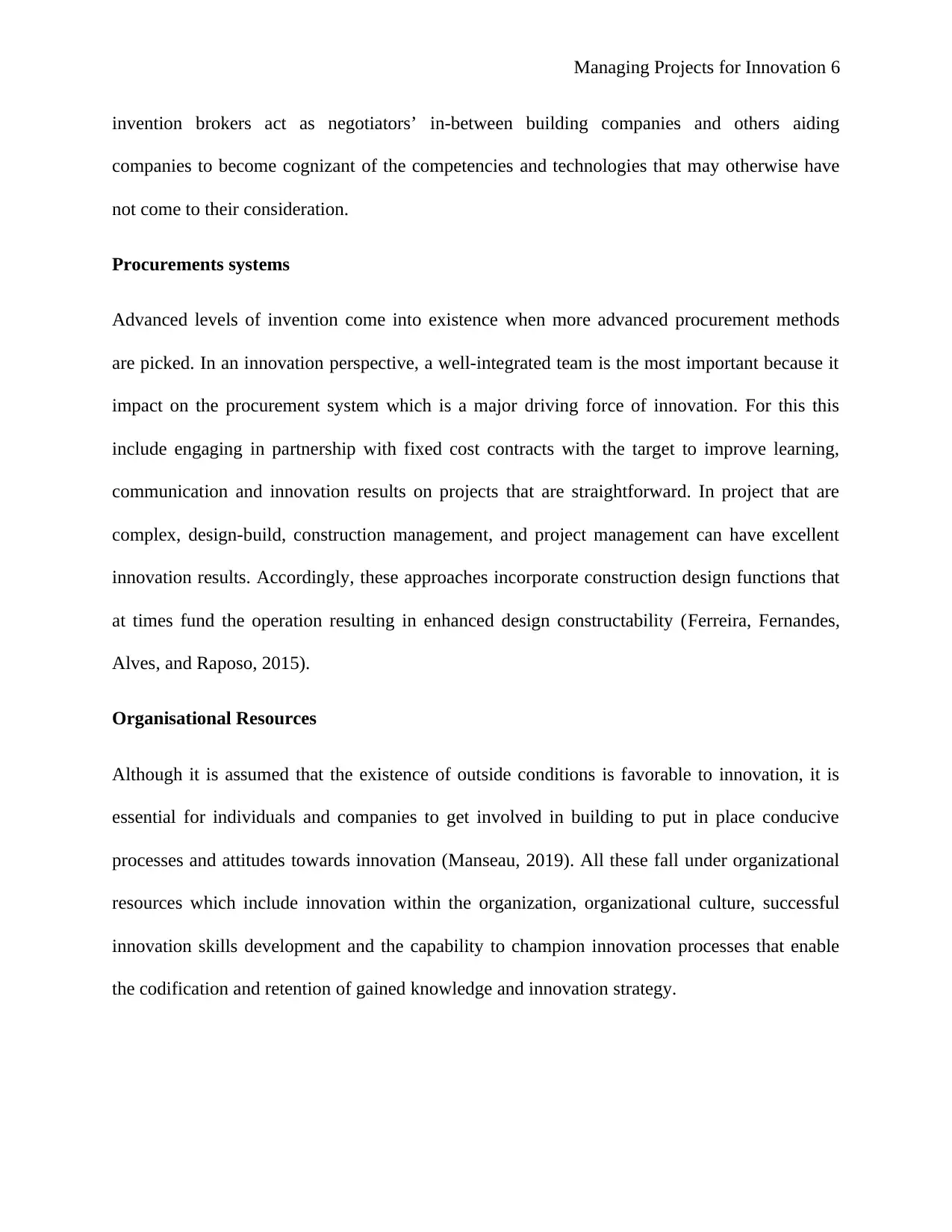
Managing Projects for Innovation 6
invention brokers act as negotiators’ in-between building companies and others aiding
companies to become cognizant of the competencies and technologies that may otherwise have
not come to their consideration.
Procurements systems
Advanced levels of invention come into existence when more advanced procurement methods
are picked. In an innovation perspective, a well-integrated team is the most important because it
impact on the procurement system which is a major driving force of innovation. For this this
include engaging in partnership with fixed cost contracts with the target to improve learning,
communication and innovation results on projects that are straightforward. In project that are
complex, design-build, construction management, and project management can have excellent
innovation results. Accordingly, these approaches incorporate construction design functions that
at times fund the operation resulting in enhanced design constructability (Ferreira, Fernandes,
Alves, and Raposo, 2015).
Organisational Resources
Although it is assumed that the existence of outside conditions is favorable to innovation, it is
essential for individuals and companies to get involved in building to put in place conducive
processes and attitudes towards innovation (Manseau, 2019). All these fall under organizational
resources which include innovation within the organization, organizational culture, successful
innovation skills development and the capability to champion innovation processes that enable
the codification and retention of gained knowledge and innovation strategy.
invention brokers act as negotiators’ in-between building companies and others aiding
companies to become cognizant of the competencies and technologies that may otherwise have
not come to their consideration.
Procurements systems
Advanced levels of invention come into existence when more advanced procurement methods
are picked. In an innovation perspective, a well-integrated team is the most important because it
impact on the procurement system which is a major driving force of innovation. For this this
include engaging in partnership with fixed cost contracts with the target to improve learning,
communication and innovation results on projects that are straightforward. In project that are
complex, design-build, construction management, and project management can have excellent
innovation results. Accordingly, these approaches incorporate construction design functions that
at times fund the operation resulting in enhanced design constructability (Ferreira, Fernandes,
Alves, and Raposo, 2015).
Organisational Resources
Although it is assumed that the existence of outside conditions is favorable to innovation, it is
essential for individuals and companies to get involved in building to put in place conducive
processes and attitudes towards innovation (Manseau, 2019). All these fall under organizational
resources which include innovation within the organization, organizational culture, successful
innovation skills development and the capability to champion innovation processes that enable
the codification and retention of gained knowledge and innovation strategy.
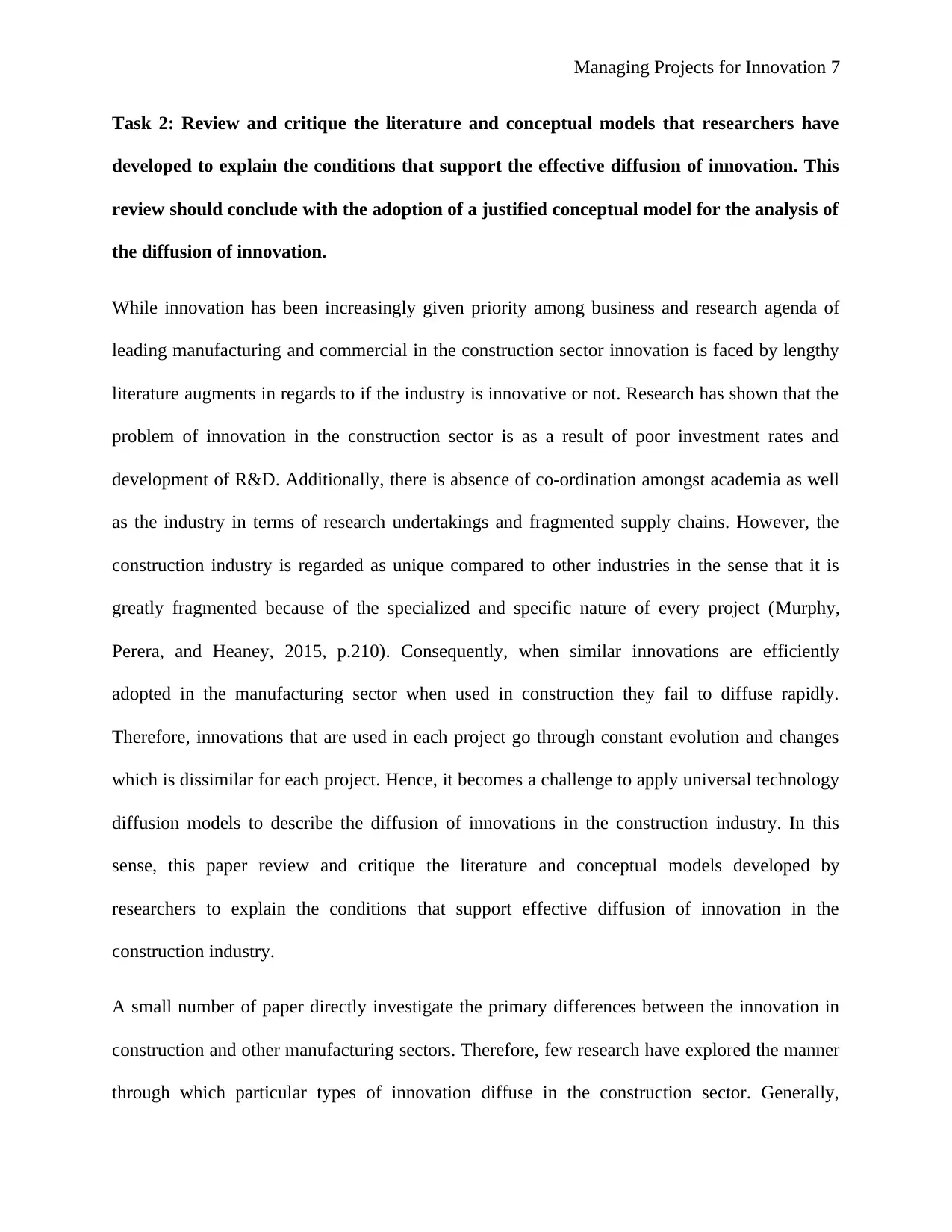
Managing Projects for Innovation 7
Task 2: Review and critique the literature and conceptual models that researchers have
developed to explain the conditions that support the effective diffusion of innovation. This
review should conclude with the adoption of a justified conceptual model for the analysis of
the diffusion of innovation.
While innovation has been increasingly given priority among business and research agenda of
leading manufacturing and commercial in the construction sector innovation is faced by lengthy
literature augments in regards to if the industry is innovative or not. Research has shown that the
problem of innovation in the construction sector is as a result of poor investment rates and
development of R&D. Additionally, there is absence of co-ordination amongst academia as well
as the industry in terms of research undertakings and fragmented supply chains. However, the
construction industry is regarded as unique compared to other industries in the sense that it is
greatly fragmented because of the specialized and specific nature of every project (Murphy,
Perera, and Heaney, 2015, p.210). Consequently, when similar innovations are efficiently
adopted in the manufacturing sector when used in construction they fail to diffuse rapidly.
Therefore, innovations that are used in each project go through constant evolution and changes
which is dissimilar for each project. Hence, it becomes a challenge to apply universal technology
diffusion models to describe the diffusion of innovations in the construction industry. In this
sense, this paper review and critique the literature and conceptual models developed by
researchers to explain the conditions that support effective diffusion of innovation in the
construction industry.
A small number of paper directly investigate the primary differences between the innovation in
construction and other manufacturing sectors. Therefore, few research have explored the manner
through which particular types of innovation diffuse in the construction sector. Generally,
Task 2: Review and critique the literature and conceptual models that researchers have
developed to explain the conditions that support the effective diffusion of innovation. This
review should conclude with the adoption of a justified conceptual model for the analysis of
the diffusion of innovation.
While innovation has been increasingly given priority among business and research agenda of
leading manufacturing and commercial in the construction sector innovation is faced by lengthy
literature augments in regards to if the industry is innovative or not. Research has shown that the
problem of innovation in the construction sector is as a result of poor investment rates and
development of R&D. Additionally, there is absence of co-ordination amongst academia as well
as the industry in terms of research undertakings and fragmented supply chains. However, the
construction industry is regarded as unique compared to other industries in the sense that it is
greatly fragmented because of the specialized and specific nature of every project (Murphy,
Perera, and Heaney, 2015, p.210). Consequently, when similar innovations are efficiently
adopted in the manufacturing sector when used in construction they fail to diffuse rapidly.
Therefore, innovations that are used in each project go through constant evolution and changes
which is dissimilar for each project. Hence, it becomes a challenge to apply universal technology
diffusion models to describe the diffusion of innovations in the construction industry. In this
sense, this paper review and critique the literature and conceptual models developed by
researchers to explain the conditions that support effective diffusion of innovation in the
construction industry.
A small number of paper directly investigate the primary differences between the innovation in
construction and other manufacturing sectors. Therefore, few research have explored the manner
through which particular types of innovation diffuse in the construction sector. Generally,
Paraphrase This Document
Need a fresh take? Get an instant paraphrase of this document with our AI Paraphraser
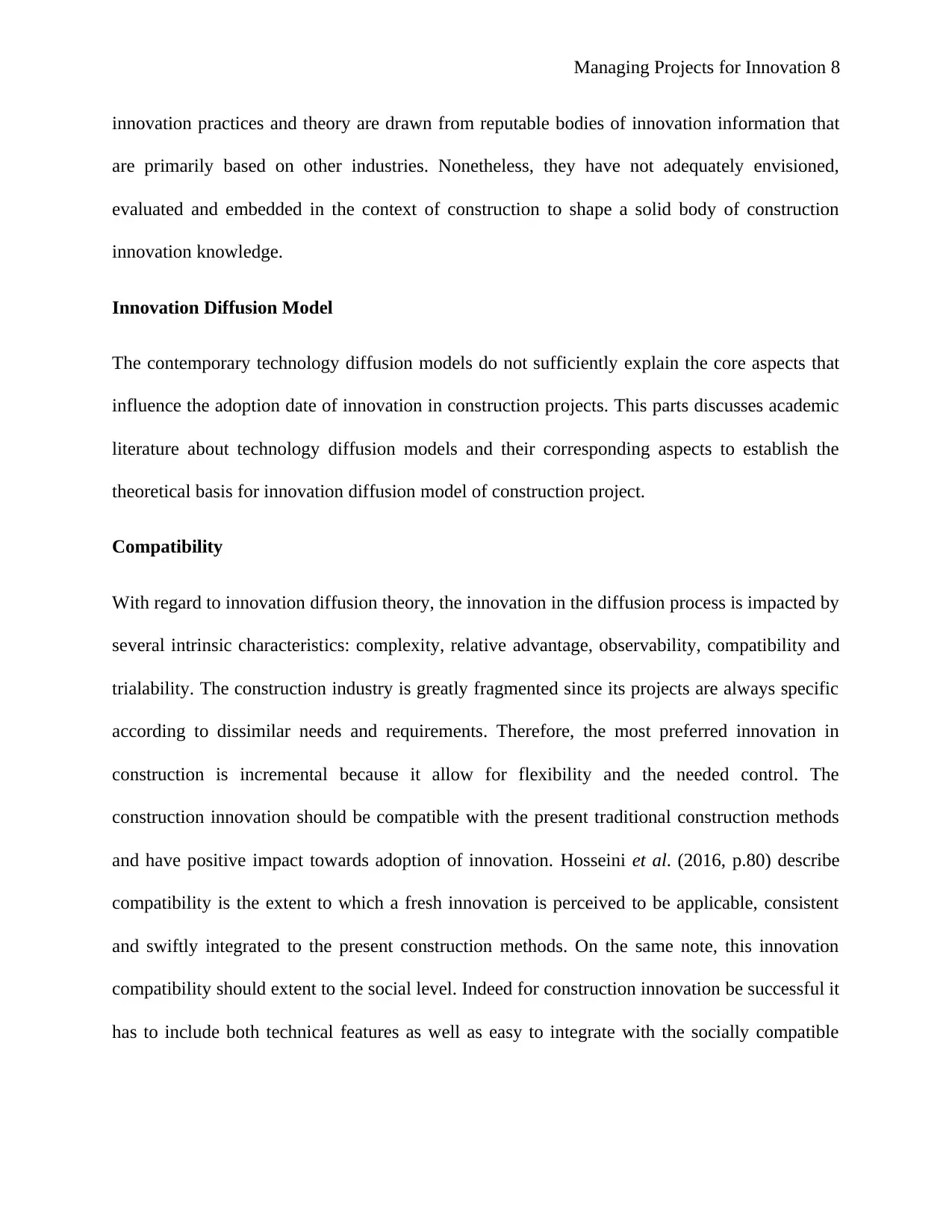
Managing Projects for Innovation 8
innovation practices and theory are drawn from reputable bodies of innovation information that
are primarily based on other industries. Nonetheless, they have not adequately envisioned,
evaluated and embedded in the context of construction to shape a solid body of construction
innovation knowledge.
Innovation Diffusion Model
The contemporary technology diffusion models do not sufficiently explain the core aspects that
influence the adoption date of innovation in construction projects. This parts discusses academic
literature about technology diffusion models and their corresponding aspects to establish the
theoretical basis for innovation diffusion model of construction project.
Compatibility
With regard to innovation diffusion theory, the innovation in the diffusion process is impacted by
several intrinsic characteristics: complexity, relative advantage, observability, compatibility and
trialability. The construction industry is greatly fragmented since its projects are always specific
according to dissimilar needs and requirements. Therefore, the most preferred innovation in
construction is incremental because it allow for flexibility and the needed control. The
construction innovation should be compatible with the present traditional construction methods
and have positive impact towards adoption of innovation. Hosseini et al. (2016, p.80) describe
compatibility is the extent to which a fresh innovation is perceived to be applicable, consistent
and swiftly integrated to the present construction methods. On the same note, this innovation
compatibility should extent to the social level. Indeed for construction innovation be successful it
has to include both technical features as well as easy to integrate with the socially compatible
innovation practices and theory are drawn from reputable bodies of innovation information that
are primarily based on other industries. Nonetheless, they have not adequately envisioned,
evaluated and embedded in the context of construction to shape a solid body of construction
innovation knowledge.
Innovation Diffusion Model
The contemporary technology diffusion models do not sufficiently explain the core aspects that
influence the adoption date of innovation in construction projects. This parts discusses academic
literature about technology diffusion models and their corresponding aspects to establish the
theoretical basis for innovation diffusion model of construction project.
Compatibility
With regard to innovation diffusion theory, the innovation in the diffusion process is impacted by
several intrinsic characteristics: complexity, relative advantage, observability, compatibility and
trialability. The construction industry is greatly fragmented since its projects are always specific
according to dissimilar needs and requirements. Therefore, the most preferred innovation in
construction is incremental because it allow for flexibility and the needed control. The
construction innovation should be compatible with the present traditional construction methods
and have positive impact towards adoption of innovation. Hosseini et al. (2016, p.80) describe
compatibility is the extent to which a fresh innovation is perceived to be applicable, consistent
and swiftly integrated to the present construction methods. On the same note, this innovation
compatibility should extent to the social level. Indeed for construction innovation be successful it
has to include both technical features as well as easy to integrate with the socially compatible
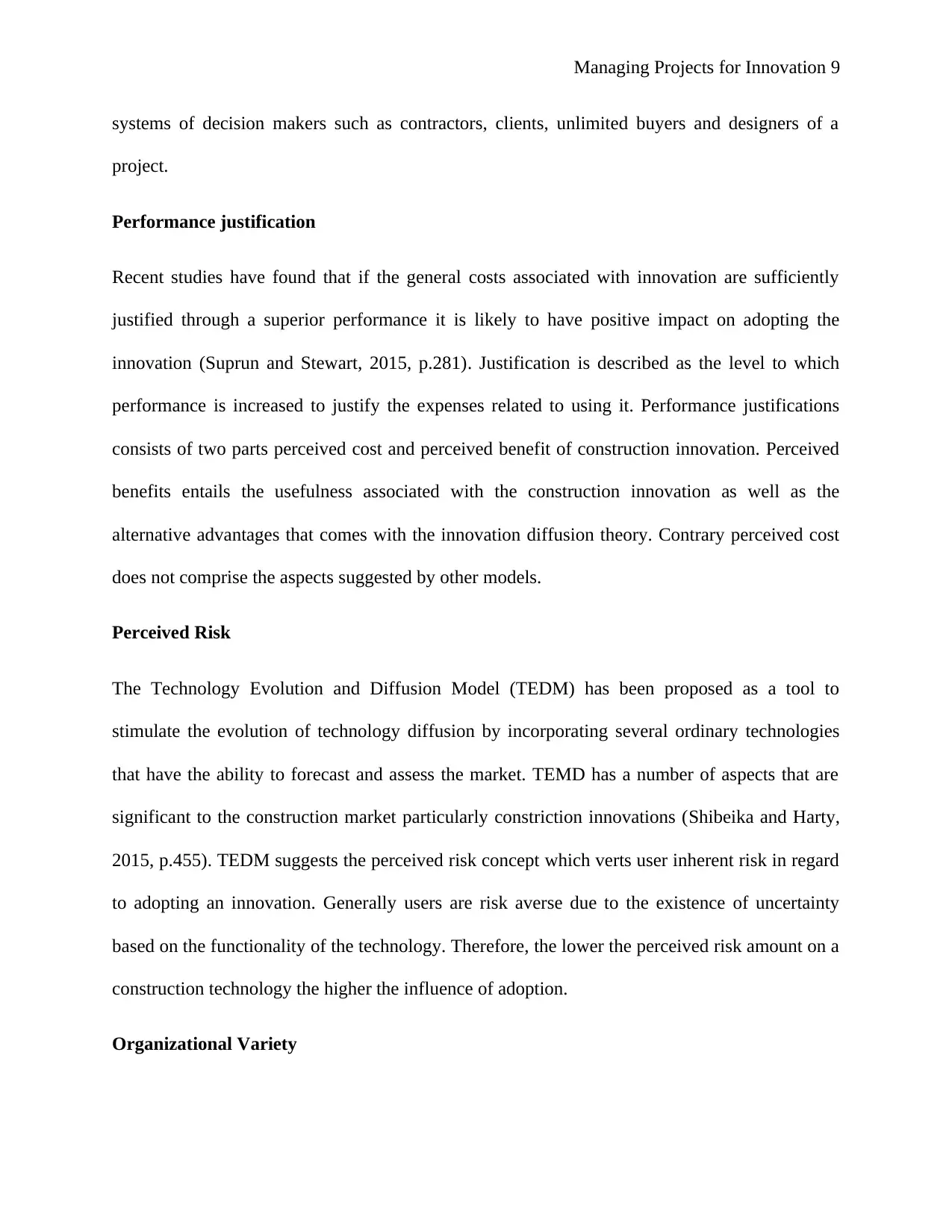
Managing Projects for Innovation 9
systems of decision makers such as contractors, clients, unlimited buyers and designers of a
project.
Performance justification
Recent studies have found that if the general costs associated with innovation are sufficiently
justified through a superior performance it is likely to have positive impact on adopting the
innovation (Suprun and Stewart, 2015, p.281). Justification is described as the level to which
performance is increased to justify the expenses related to using it. Performance justifications
consists of two parts perceived cost and perceived benefit of construction innovation. Perceived
benefits entails the usefulness associated with the construction innovation as well as the
alternative advantages that comes with the innovation diffusion theory. Contrary perceived cost
does not comprise the aspects suggested by other models.
Perceived Risk
The Technology Evolution and Diffusion Model (TEDM) has been proposed as a tool to
stimulate the evolution of technology diffusion by incorporating several ordinary technologies
that have the ability to forecast and assess the market. TEMD has a number of aspects that are
significant to the construction market particularly constriction innovations (Shibeika and Harty,
2015, p.455). TEDM suggests the perceived risk concept which verts user inherent risk in regard
to adopting an innovation. Generally users are risk averse due to the existence of uncertainty
based on the functionality of the technology. Therefore, the lower the perceived risk amount on a
construction technology the higher the influence of adoption.
Organizational Variety
systems of decision makers such as contractors, clients, unlimited buyers and designers of a
project.
Performance justification
Recent studies have found that if the general costs associated with innovation are sufficiently
justified through a superior performance it is likely to have positive impact on adopting the
innovation (Suprun and Stewart, 2015, p.281). Justification is described as the level to which
performance is increased to justify the expenses related to using it. Performance justifications
consists of two parts perceived cost and perceived benefit of construction innovation. Perceived
benefits entails the usefulness associated with the construction innovation as well as the
alternative advantages that comes with the innovation diffusion theory. Contrary perceived cost
does not comprise the aspects suggested by other models.
Perceived Risk
The Technology Evolution and Diffusion Model (TEDM) has been proposed as a tool to
stimulate the evolution of technology diffusion by incorporating several ordinary technologies
that have the ability to forecast and assess the market. TEMD has a number of aspects that are
significant to the construction market particularly constriction innovations (Shibeika and Harty,
2015, p.455). TEDM suggests the perceived risk concept which verts user inherent risk in regard
to adopting an innovation. Generally users are risk averse due to the existence of uncertainty
based on the functionality of the technology. Therefore, the lower the perceived risk amount on a
construction technology the higher the influence of adoption.
Organizational Variety
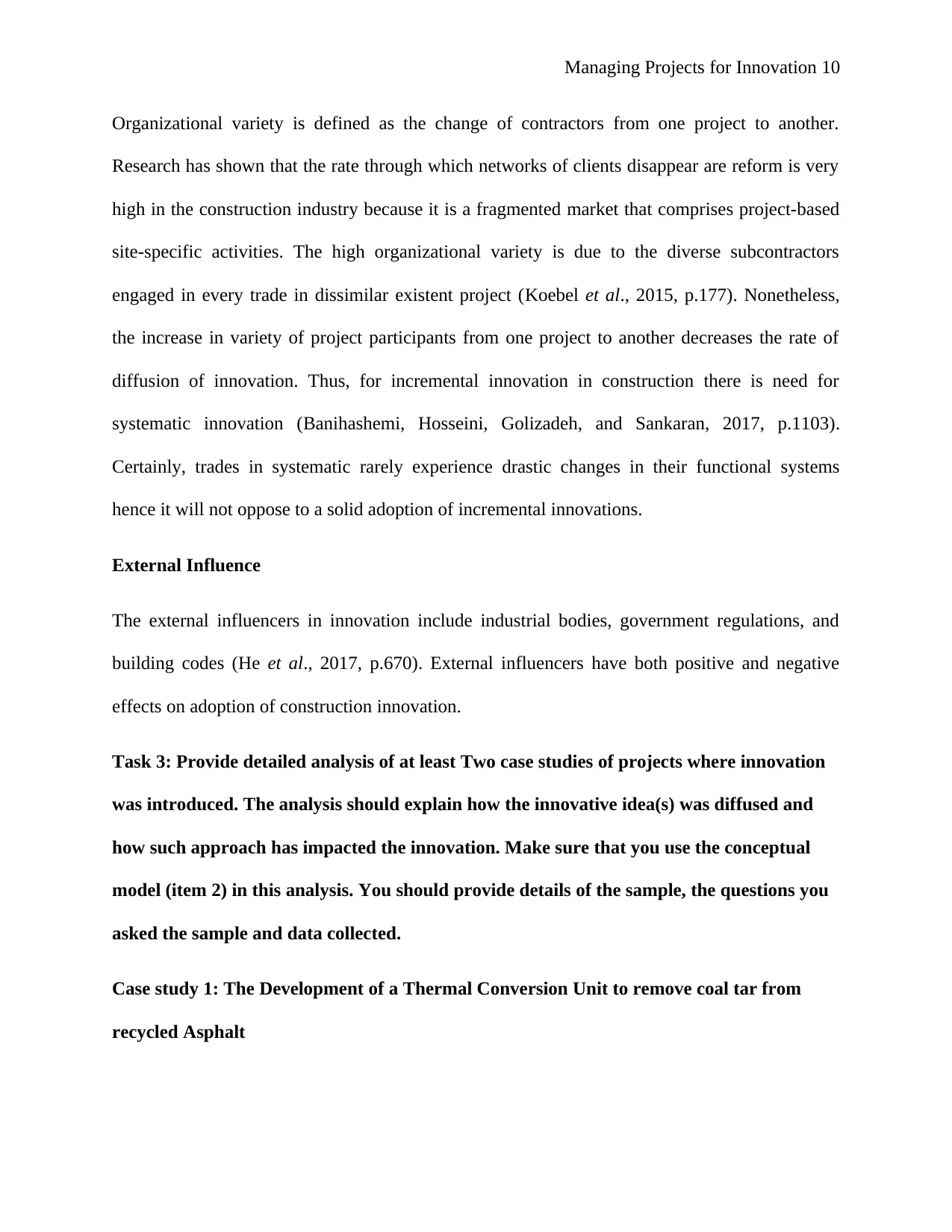
Managing Projects for Innovation 10
Organizational variety is defined as the change of contractors from one project to another.
Research has shown that the rate through which networks of clients disappear are reform is very
high in the construction industry because it is a fragmented market that comprises project-based
site-specific activities. The high organizational variety is due to the diverse subcontractors
engaged in every trade in dissimilar existent project (Koebel et al., 2015, p.177). Nonetheless,
the increase in variety of project participants from one project to another decreases the rate of
diffusion of innovation. Thus, for incremental innovation in construction there is need for
systematic innovation (Banihashemi, Hosseini, Golizadeh, and Sankaran, 2017, p.1103).
Certainly, trades in systematic rarely experience drastic changes in their functional systems
hence it will not oppose to a solid adoption of incremental innovations.
External Influence
The external influencers in innovation include industrial bodies, government regulations, and
building codes (He et al., 2017, p.670). External influencers have both positive and negative
effects on adoption of construction innovation.
Task 3: Provide detailed analysis of at least Two case studies of projects where innovation
was introduced. The analysis should explain how the innovative idea(s) was diffused and
how such approach has impacted the innovation. Make sure that you use the conceptual
model (item 2) in this analysis. You should provide details of the sample, the questions you
asked the sample and data collected.
Case study 1: The Development of a Thermal Conversion Unit to remove coal tar from
recycled Asphalt
Organizational variety is defined as the change of contractors from one project to another.
Research has shown that the rate through which networks of clients disappear are reform is very
high in the construction industry because it is a fragmented market that comprises project-based
site-specific activities. The high organizational variety is due to the diverse subcontractors
engaged in every trade in dissimilar existent project (Koebel et al., 2015, p.177). Nonetheless,
the increase in variety of project participants from one project to another decreases the rate of
diffusion of innovation. Thus, for incremental innovation in construction there is need for
systematic innovation (Banihashemi, Hosseini, Golizadeh, and Sankaran, 2017, p.1103).
Certainly, trades in systematic rarely experience drastic changes in their functional systems
hence it will not oppose to a solid adoption of incremental innovations.
External Influence
The external influencers in innovation include industrial bodies, government regulations, and
building codes (He et al., 2017, p.670). External influencers have both positive and negative
effects on adoption of construction innovation.
Task 3: Provide detailed analysis of at least Two case studies of projects where innovation
was introduced. The analysis should explain how the innovative idea(s) was diffused and
how such approach has impacted the innovation. Make sure that you use the conceptual
model (item 2) in this analysis. You should provide details of the sample, the questions you
asked the sample and data collected.
Case study 1: The Development of a Thermal Conversion Unit to remove coal tar from
recycled Asphalt
Secure Best Marks with AI Grader
Need help grading? Try our AI Grader for instant feedback on your assignments.
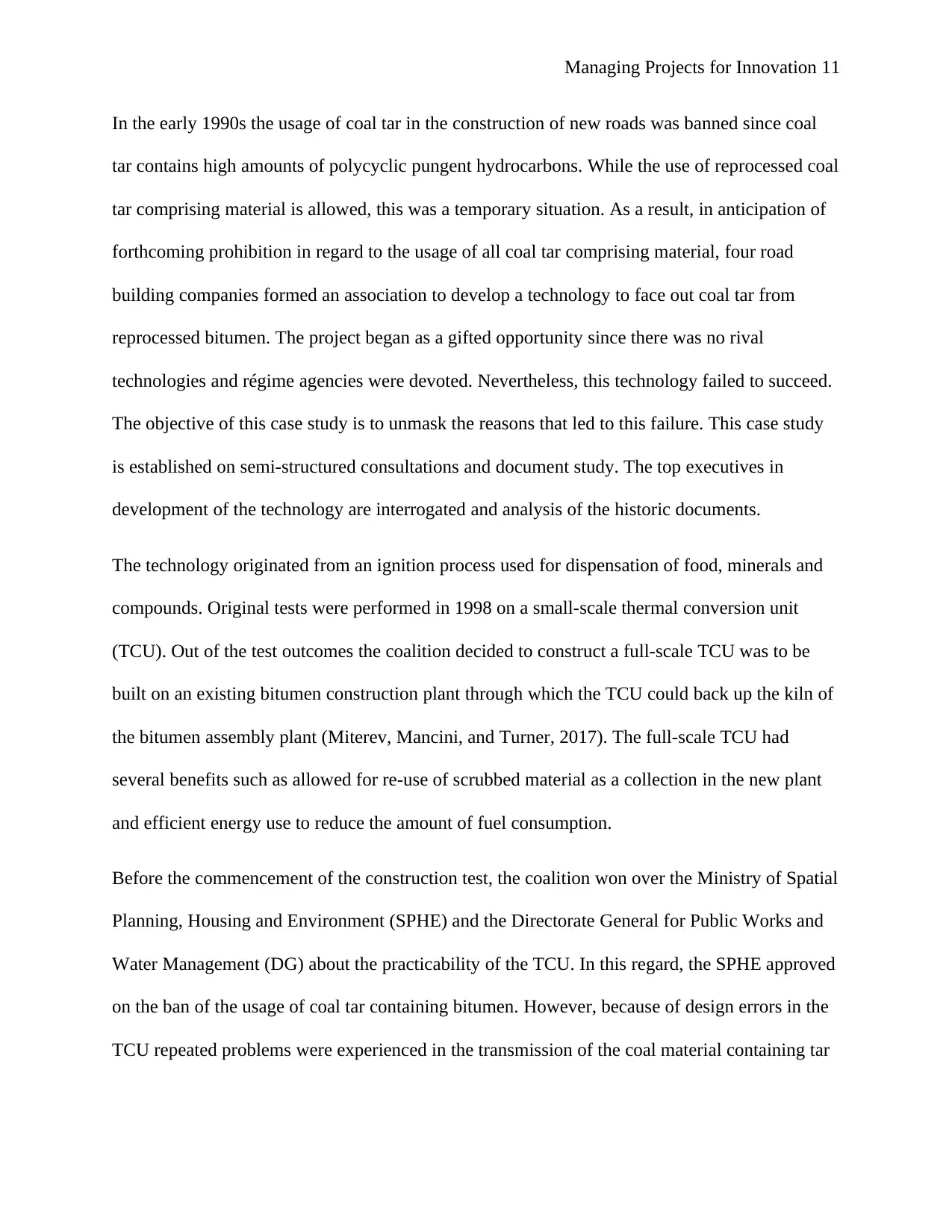
Managing Projects for Innovation 11
In the early 1990s the usage of coal tar in the construction of new roads was banned since coal
tar contains high amounts of polycyclic pungent hydrocarbons. While the use of reprocessed coal
tar comprising material is allowed, this was a temporary situation. As a result, in anticipation of
forthcoming prohibition in regard to the usage of all coal tar comprising material, four road
building companies formed an association to develop a technology to face out coal tar from
reprocessed bitumen. The project began as a gifted opportunity since there was no rival
technologies and régime agencies were devoted. Nevertheless, this technology failed to succeed.
The objective of this case study is to unmask the reasons that led to this failure. This case study
is established on semi-structured consultations and document study. The top executives in
development of the technology are interrogated and analysis of the historic documents.
The technology originated from an ignition process used for dispensation of food, minerals and
compounds. Original tests were performed in 1998 on a small-scale thermal conversion unit
(TCU). Out of the test outcomes the coalition decided to construct a full-scale TCU was to be
built on an existing bitumen construction plant through which the TCU could back up the kiln of
the bitumen assembly plant (Miterev, Mancini, and Turner, 2017). The full-scale TCU had
several benefits such as allowed for re-use of scrubbed material as a collection in the new plant
and efficient energy use to reduce the amount of fuel consumption.
Before the commencement of the construction test, the coalition won over the Ministry of Spatial
Planning, Housing and Environment (SPHE) and the Directorate General for Public Works and
Water Management (DG) about the practicability of the TCU. In this regard, the SPHE approved
on the ban of the usage of coal tar containing bitumen. However, because of design errors in the
TCU repeated problems were experienced in the transmission of the coal material containing tar
In the early 1990s the usage of coal tar in the construction of new roads was banned since coal
tar contains high amounts of polycyclic pungent hydrocarbons. While the use of reprocessed coal
tar comprising material is allowed, this was a temporary situation. As a result, in anticipation of
forthcoming prohibition in regard to the usage of all coal tar comprising material, four road
building companies formed an association to develop a technology to face out coal tar from
reprocessed bitumen. The project began as a gifted opportunity since there was no rival
technologies and régime agencies were devoted. Nevertheless, this technology failed to succeed.
The objective of this case study is to unmask the reasons that led to this failure. This case study
is established on semi-structured consultations and document study. The top executives in
development of the technology are interrogated and analysis of the historic documents.
The technology originated from an ignition process used for dispensation of food, minerals and
compounds. Original tests were performed in 1998 on a small-scale thermal conversion unit
(TCU). Out of the test outcomes the coalition decided to construct a full-scale TCU was to be
built on an existing bitumen construction plant through which the TCU could back up the kiln of
the bitumen assembly plant (Miterev, Mancini, and Turner, 2017). The full-scale TCU had
several benefits such as allowed for re-use of scrubbed material as a collection in the new plant
and efficient energy use to reduce the amount of fuel consumption.
Before the commencement of the construction test, the coalition won over the Ministry of Spatial
Planning, Housing and Environment (SPHE) and the Directorate General for Public Works and
Water Management (DG) about the practicability of the TCU. In this regard, the SPHE approved
on the ban of the usage of coal tar containing bitumen. However, because of design errors in the
TCU repeated problems were experienced in the transmission of the coal material containing tar
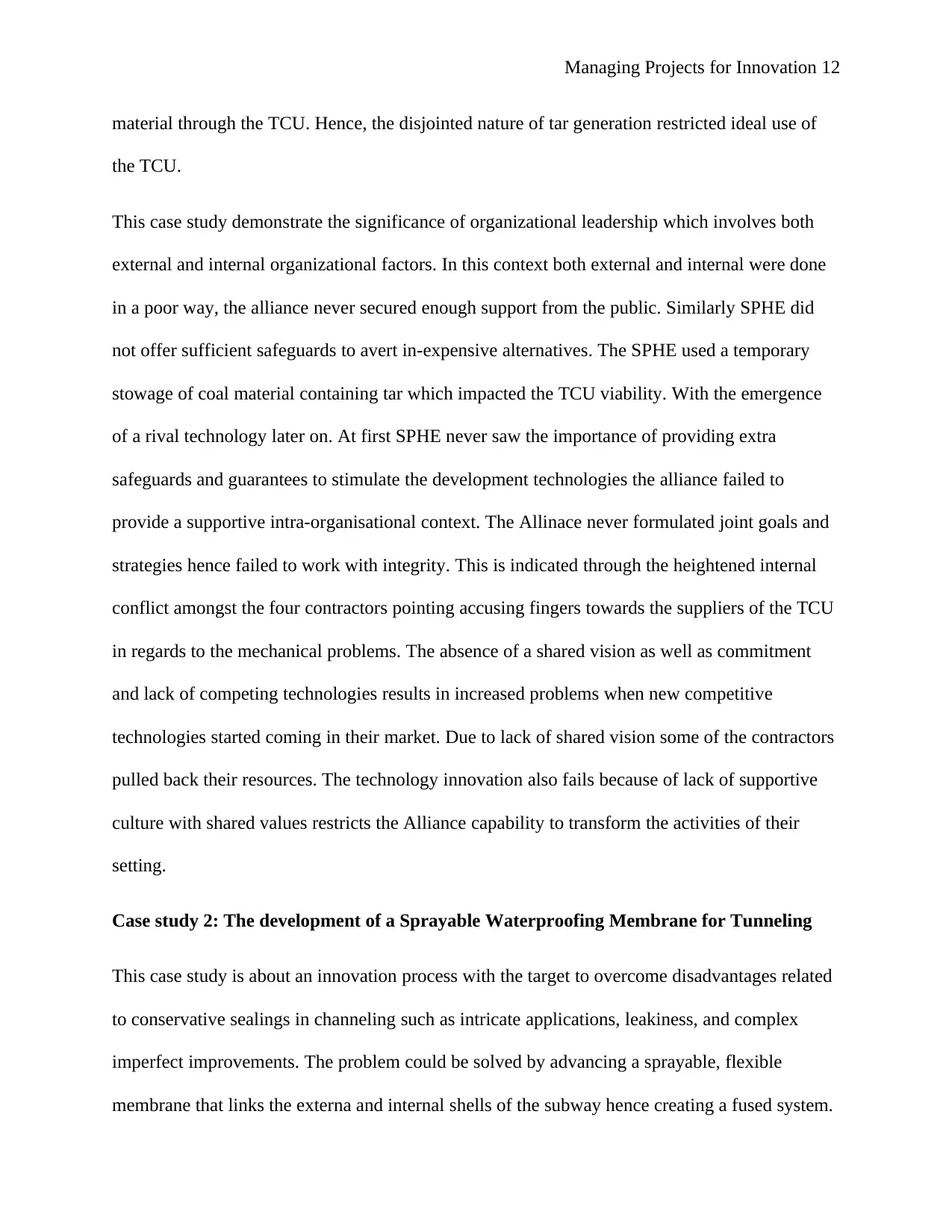
Managing Projects for Innovation 12
material through the TCU. Hence, the disjointed nature of tar generation restricted ideal use of
the TCU.
This case study demonstrate the significance of organizational leadership which involves both
external and internal organizational factors. In this context both external and internal were done
in a poor way, the alliance never secured enough support from the public. Similarly SPHE did
not offer sufficient safeguards to avert in-expensive alternatives. The SPHE used a temporary
stowage of coal material containing tar which impacted the TCU viability. With the emergence
of a rival technology later on. At first SPHE never saw the importance of providing extra
safeguards and guarantees to stimulate the development technologies the alliance failed to
provide a supportive intra-organisational context. The Allinace never formulated joint goals and
strategies hence failed to work with integrity. This is indicated through the heightened internal
conflict amongst the four contractors pointing accusing fingers towards the suppliers of the TCU
in regards to the mechanical problems. The absence of a shared vision as well as commitment
and lack of competing technologies results in increased problems when new competitive
technologies started coming in their market. Due to lack of shared vision some of the contractors
pulled back their resources. The technology innovation also fails because of lack of supportive
culture with shared values restricts the Alliance capability to transform the activities of their
setting.
Case study 2: The development of a Sprayable Waterproofing Membrane for Tunneling
This case study is about an innovation process with the target to overcome disadvantages related
to conservative sealings in channeling such as intricate applications, leakiness, and complex
imperfect improvements. The problem could be solved by advancing a sprayable, flexible
membrane that links the externa and internal shells of the subway hence creating a fused system.
material through the TCU. Hence, the disjointed nature of tar generation restricted ideal use of
the TCU.
This case study demonstrate the significance of organizational leadership which involves both
external and internal organizational factors. In this context both external and internal were done
in a poor way, the alliance never secured enough support from the public. Similarly SPHE did
not offer sufficient safeguards to avert in-expensive alternatives. The SPHE used a temporary
stowage of coal material containing tar which impacted the TCU viability. With the emergence
of a rival technology later on. At first SPHE never saw the importance of providing extra
safeguards and guarantees to stimulate the development technologies the alliance failed to
provide a supportive intra-organisational context. The Allinace never formulated joint goals and
strategies hence failed to work with integrity. This is indicated through the heightened internal
conflict amongst the four contractors pointing accusing fingers towards the suppliers of the TCU
in regards to the mechanical problems. The absence of a shared vision as well as commitment
and lack of competing technologies results in increased problems when new competitive
technologies started coming in their market. Due to lack of shared vision some of the contractors
pulled back their resources. The technology innovation also fails because of lack of supportive
culture with shared values restricts the Alliance capability to transform the activities of their
setting.
Case study 2: The development of a Sprayable Waterproofing Membrane for Tunneling
This case study is about an innovation process with the target to overcome disadvantages related
to conservative sealings in channeling such as intricate applications, leakiness, and complex
imperfect improvements. The problem could be solved by advancing a sprayable, flexible
membrane that links the externa and internal shells of the subway hence creating a fused system.
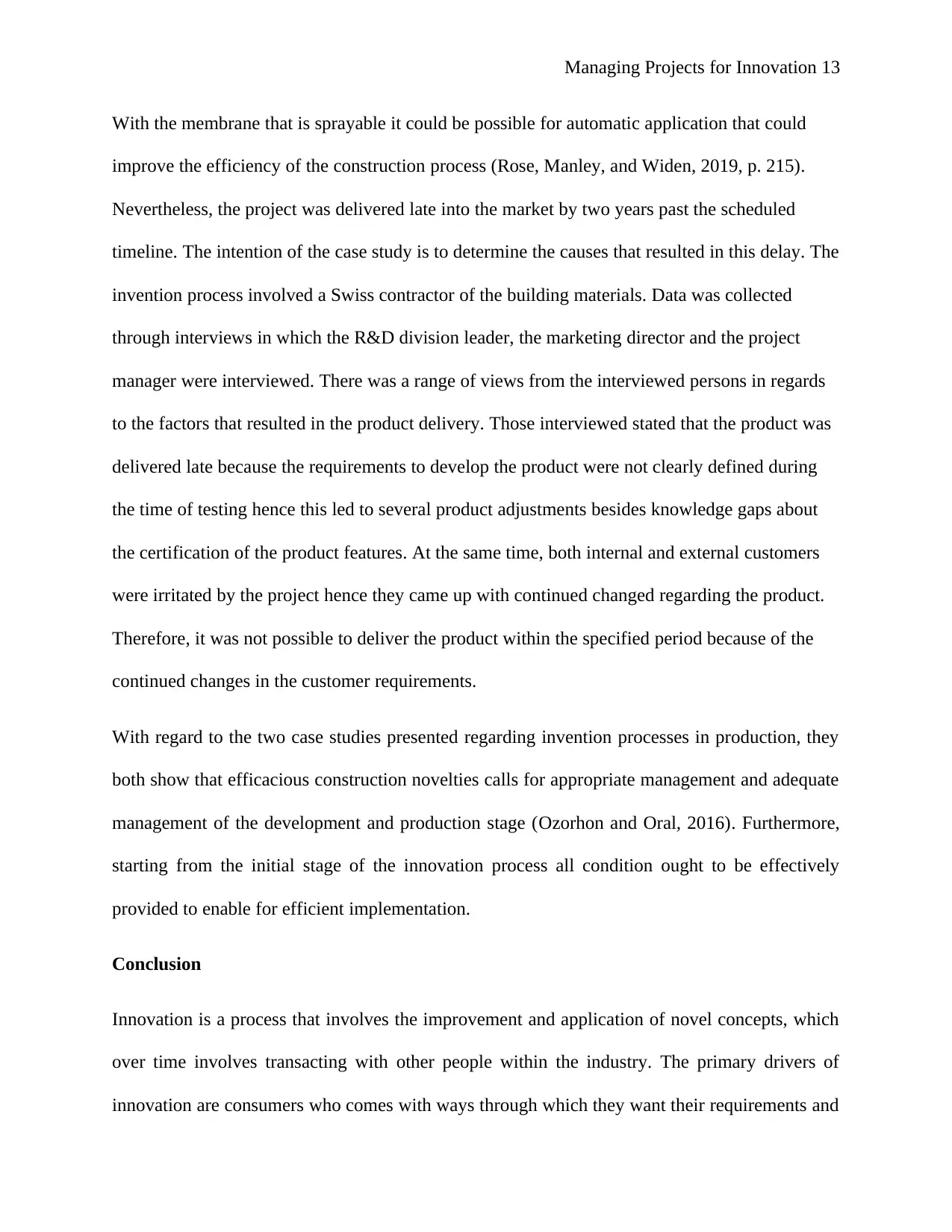
Managing Projects for Innovation 13
With the membrane that is sprayable it could be possible for automatic application that could
improve the efficiency of the construction process (Rose, Manley, and Widen, 2019, p. 215).
Nevertheless, the project was delivered late into the market by two years past the scheduled
timeline. The intention of the case study is to determine the causes that resulted in this delay. The
invention process involved a Swiss contractor of the building materials. Data was collected
through interviews in which the R&D division leader, the marketing director and the project
manager were interviewed. There was a range of views from the interviewed persons in regards
to the factors that resulted in the product delivery. Those interviewed stated that the product was
delivered late because the requirements to develop the product were not clearly defined during
the time of testing hence this led to several product adjustments besides knowledge gaps about
the certification of the product features. At the same time, both internal and external customers
were irritated by the project hence they came up with continued changed regarding the product.
Therefore, it was not possible to deliver the product within the specified period because of the
continued changes in the customer requirements.
With regard to the two case studies presented regarding invention processes in production, they
both show that efficacious construction novelties calls for appropriate management and adequate
management of the development and production stage (Ozorhon and Oral, 2016). Furthermore,
starting from the initial stage of the innovation process all condition ought to be effectively
provided to enable for efficient implementation.
Conclusion
Innovation is a process that involves the improvement and application of novel concepts, which
over time involves transacting with other people within the industry. The primary drivers of
innovation are consumers who comes with ways through which they want their requirements and
With the membrane that is sprayable it could be possible for automatic application that could
improve the efficiency of the construction process (Rose, Manley, and Widen, 2019, p. 215).
Nevertheless, the project was delivered late into the market by two years past the scheduled
timeline. The intention of the case study is to determine the causes that resulted in this delay. The
invention process involved a Swiss contractor of the building materials. Data was collected
through interviews in which the R&D division leader, the marketing director and the project
manager were interviewed. There was a range of views from the interviewed persons in regards
to the factors that resulted in the product delivery. Those interviewed stated that the product was
delivered late because the requirements to develop the product were not clearly defined during
the time of testing hence this led to several product adjustments besides knowledge gaps about
the certification of the product features. At the same time, both internal and external customers
were irritated by the project hence they came up with continued changed regarding the product.
Therefore, it was not possible to deliver the product within the specified period because of the
continued changes in the customer requirements.
With regard to the two case studies presented regarding invention processes in production, they
both show that efficacious construction novelties calls for appropriate management and adequate
management of the development and production stage (Ozorhon and Oral, 2016). Furthermore,
starting from the initial stage of the innovation process all condition ought to be effectively
provided to enable for efficient implementation.
Conclusion
Innovation is a process that involves the improvement and application of novel concepts, which
over time involves transacting with other people within the industry. The primary drivers of
innovation are consumers who comes with ways through which they want their requirements and
Paraphrase This Document
Need a fresh take? Get an instant paraphrase of this document with our AI Paraphraser
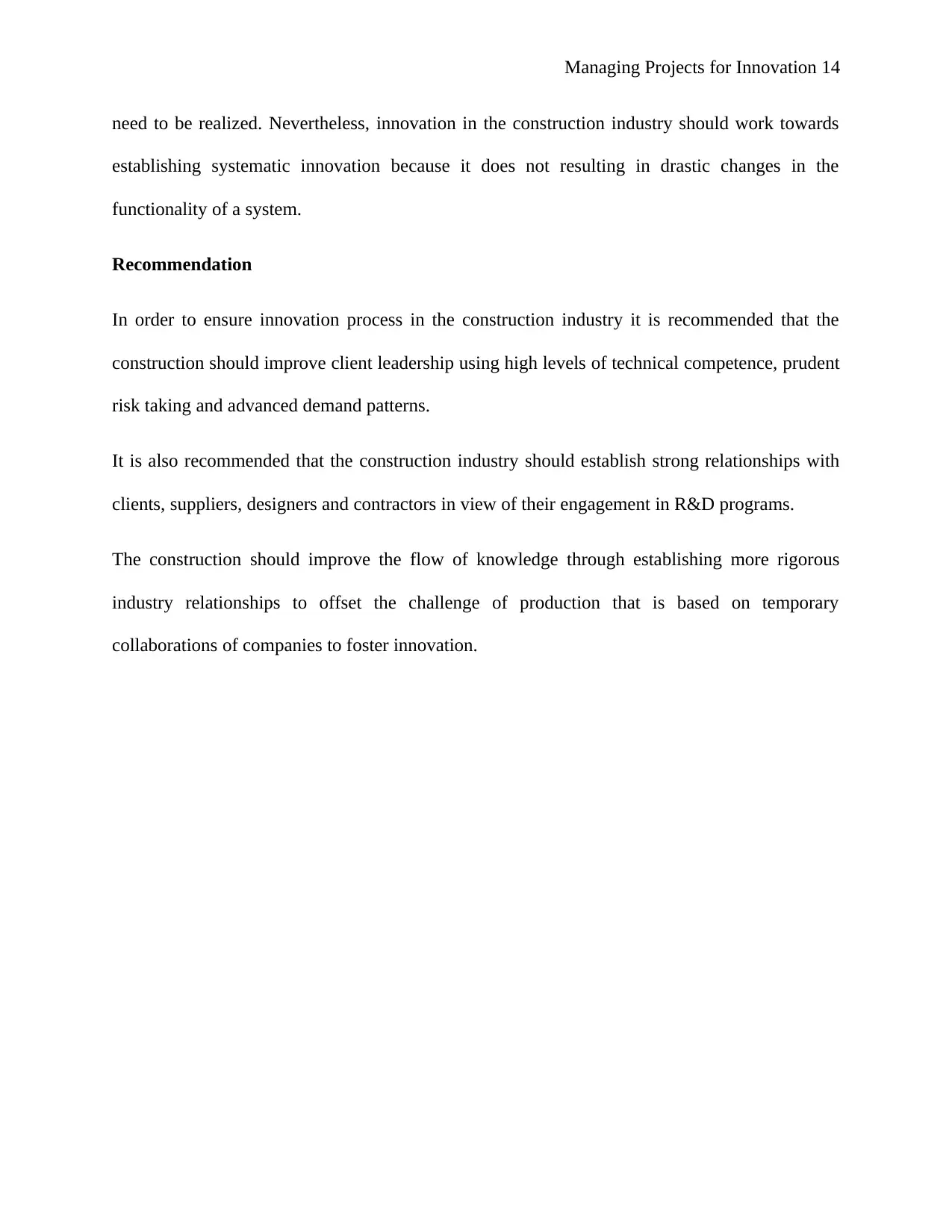
Managing Projects for Innovation 14
need to be realized. Nevertheless, innovation in the construction industry should work towards
establishing systematic innovation because it does not resulting in drastic changes in the
functionality of a system.
Recommendation
In order to ensure innovation process in the construction industry it is recommended that the
construction should improve client leadership using high levels of technical competence, prudent
risk taking and advanced demand patterns.
It is also recommended that the construction industry should establish strong relationships with
clients, suppliers, designers and contractors in view of their engagement in R&D programs.
The construction should improve the flow of knowledge through establishing more rigorous
industry relationships to offset the challenge of production that is based on temporary
collaborations of companies to foster innovation.
need to be realized. Nevertheless, innovation in the construction industry should work towards
establishing systematic innovation because it does not resulting in drastic changes in the
functionality of a system.
Recommendation
In order to ensure innovation process in the construction industry it is recommended that the
construction should improve client leadership using high levels of technical competence, prudent
risk taking and advanced demand patterns.
It is also recommended that the construction industry should establish strong relationships with
clients, suppliers, designers and contractors in view of their engagement in R&D programs.
The construction should improve the flow of knowledge through establishing more rigorous
industry relationships to offset the challenge of production that is based on temporary
collaborations of companies to foster innovation.
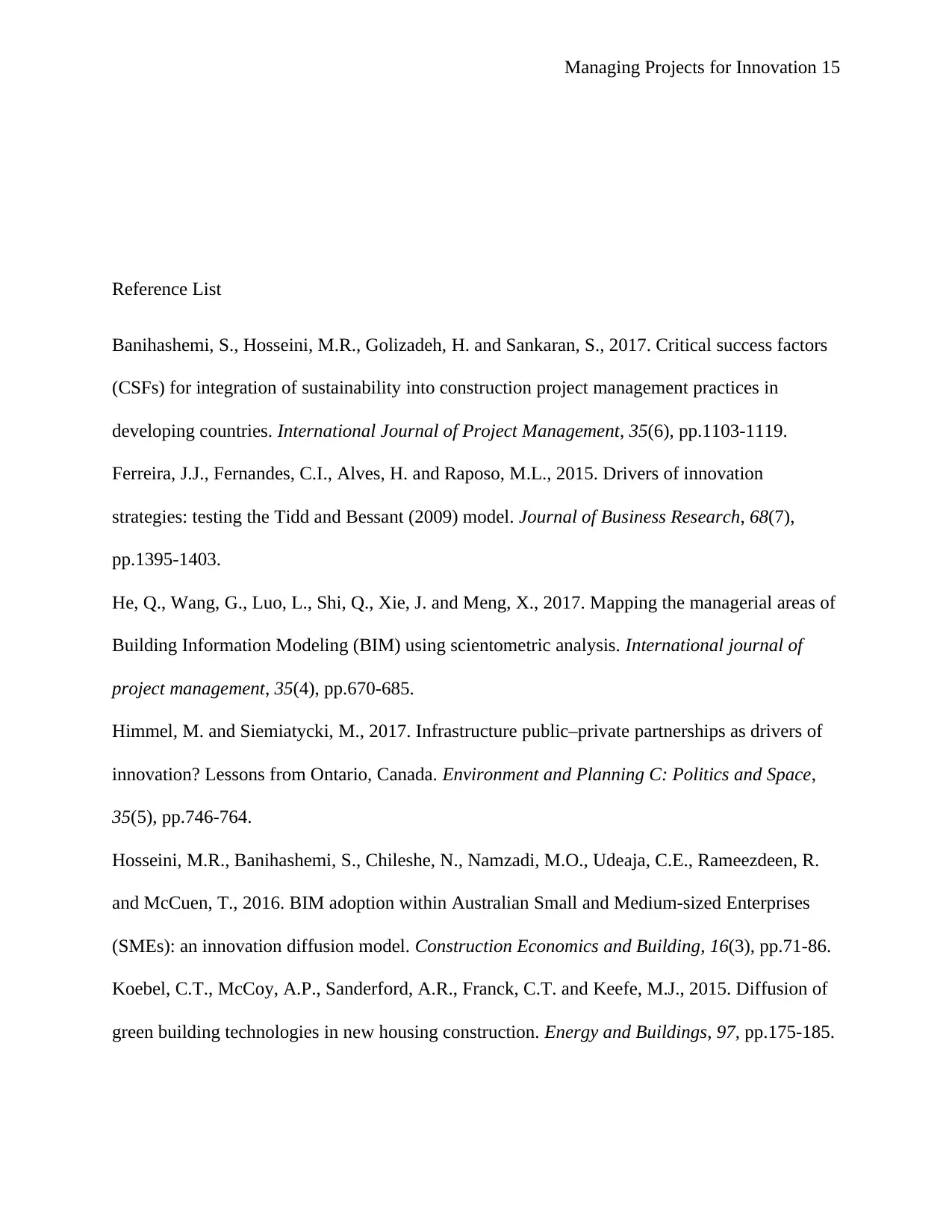
Managing Projects for Innovation 15
Reference List
Banihashemi, S., Hosseini, M.R., Golizadeh, H. and Sankaran, S., 2017. Critical success factors
(CSFs) for integration of sustainability into construction project management practices in
developing countries. International Journal of Project Management, 35(6), pp.1103-1119.
Ferreira, J.J., Fernandes, C.I., Alves, H. and Raposo, M.L., 2015. Drivers of innovation
strategies: testing the Tidd and Bessant (2009) model. Journal of Business Research, 68(7),
pp.1395-1403.
He, Q., Wang, G., Luo, L., Shi, Q., Xie, J. and Meng, X., 2017. Mapping the managerial areas of
Building Information Modeling (BIM) using scientometric analysis. International journal of
project management, 35(4), pp.670-685.
Himmel, M. and Siemiatycki, M., 2017. Infrastructure public–private partnerships as drivers of
innovation? Lessons from Ontario, Canada. Environment and Planning C: Politics and Space,
35(5), pp.746-764.
Hosseini, M.R., Banihashemi, S., Chileshe, N., Namzadi, M.O., Udeaja, C.E., Rameezdeen, R.
and McCuen, T., 2016. BIM adoption within Australian Small and Medium-sized Enterprises
(SMEs): an innovation diffusion model. Construction Economics and Building, 16(3), pp.71-86.
Koebel, C.T., McCoy, A.P., Sanderford, A.R., Franck, C.T. and Keefe, M.J., 2015. Diffusion of
green building technologies in new housing construction. Energy and Buildings, 97, pp.175-185.
Reference List
Banihashemi, S., Hosseini, M.R., Golizadeh, H. and Sankaran, S., 2017. Critical success factors
(CSFs) for integration of sustainability into construction project management practices in
developing countries. International Journal of Project Management, 35(6), pp.1103-1119.
Ferreira, J.J., Fernandes, C.I., Alves, H. and Raposo, M.L., 2015. Drivers of innovation
strategies: testing the Tidd and Bessant (2009) model. Journal of Business Research, 68(7),
pp.1395-1403.
He, Q., Wang, G., Luo, L., Shi, Q., Xie, J. and Meng, X., 2017. Mapping the managerial areas of
Building Information Modeling (BIM) using scientometric analysis. International journal of
project management, 35(4), pp.670-685.
Himmel, M. and Siemiatycki, M., 2017. Infrastructure public–private partnerships as drivers of
innovation? Lessons from Ontario, Canada. Environment and Planning C: Politics and Space,
35(5), pp.746-764.
Hosseini, M.R., Banihashemi, S., Chileshe, N., Namzadi, M.O., Udeaja, C.E., Rameezdeen, R.
and McCuen, T., 2016. BIM adoption within Australian Small and Medium-sized Enterprises
(SMEs): an innovation diffusion model. Construction Economics and Building, 16(3), pp.71-86.
Koebel, C.T., McCoy, A.P., Sanderford, A.R., Franck, C.T. and Keefe, M.J., 2015. Diffusion of
green building technologies in new housing construction. Energy and Buildings, 97, pp.175-185.
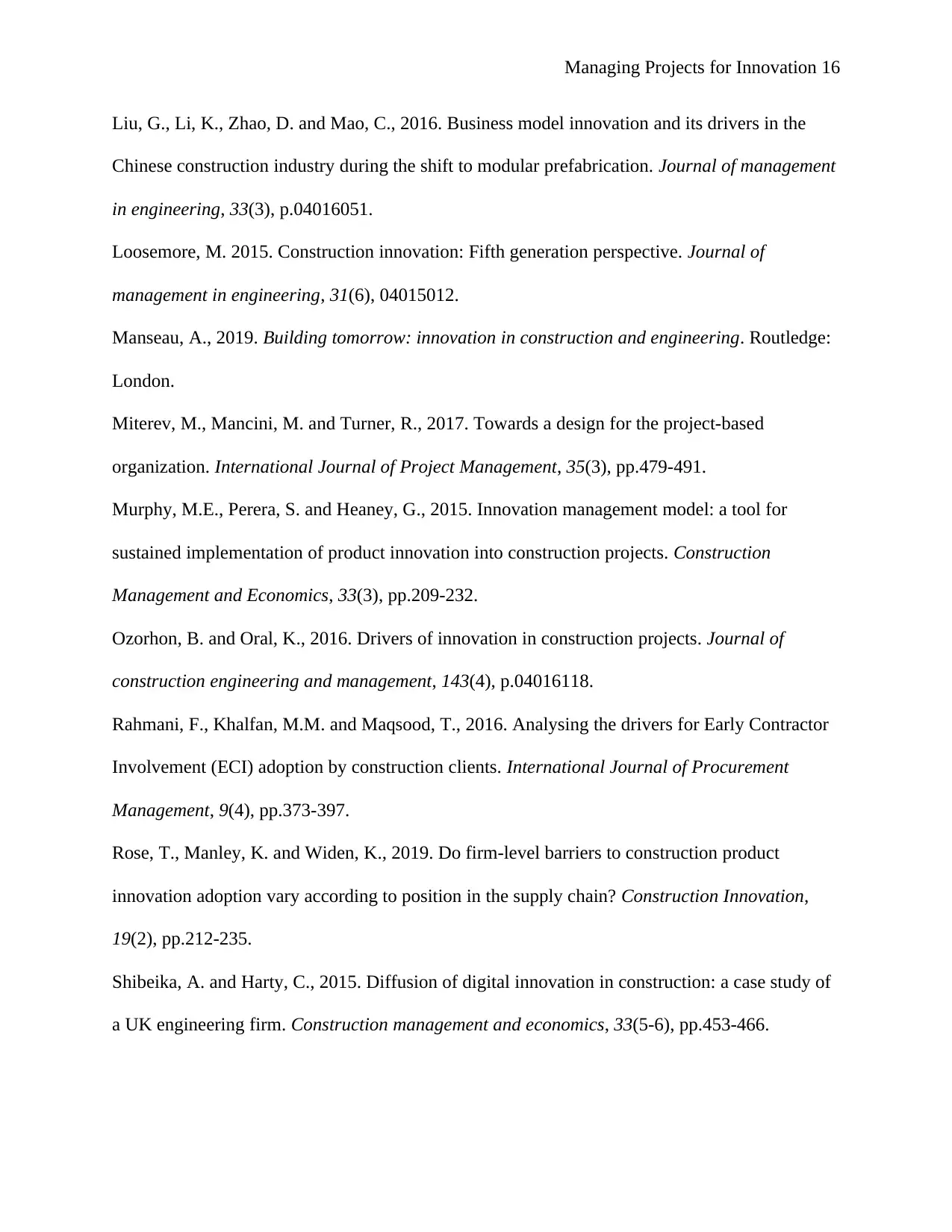
Managing Projects for Innovation 16
Liu, G., Li, K., Zhao, D. and Mao, C., 2016. Business model innovation and its drivers in the
Chinese construction industry during the shift to modular prefabrication. Journal of management
in engineering, 33(3), p.04016051.
Loosemore, M. 2015. Construction innovation: Fifth generation perspective. Journal of
management in engineering, 31(6), 04015012.
Manseau, A., 2019. Building tomorrow: innovation in construction and engineering. Routledge:
London.
Miterev, M., Mancini, M. and Turner, R., 2017. Towards a design for the project-based
organization. International Journal of Project Management, 35(3), pp.479-491.
Murphy, M.E., Perera, S. and Heaney, G., 2015. Innovation management model: a tool for
sustained implementation of product innovation into construction projects. Construction
Management and Economics, 33(3), pp.209-232.
Ozorhon, B. and Oral, K., 2016. Drivers of innovation in construction projects. Journal of
construction engineering and management, 143(4), p.04016118.
Rahmani, F., Khalfan, M.M. and Maqsood, T., 2016. Analysing the drivers for Early Contractor
Involvement (ECI) adoption by construction clients. International Journal of Procurement
Management, 9(4), pp.373-397.
Rose, T., Manley, K. and Widen, K., 2019. Do firm-level barriers to construction product
innovation adoption vary according to position in the supply chain? Construction Innovation,
19(2), pp.212-235.
Shibeika, A. and Harty, C., 2015. Diffusion of digital innovation in construction: a case study of
a UK engineering firm. Construction management and economics, 33(5-6), pp.453-466.
Liu, G., Li, K., Zhao, D. and Mao, C., 2016. Business model innovation and its drivers in the
Chinese construction industry during the shift to modular prefabrication. Journal of management
in engineering, 33(3), p.04016051.
Loosemore, M. 2015. Construction innovation: Fifth generation perspective. Journal of
management in engineering, 31(6), 04015012.
Manseau, A., 2019. Building tomorrow: innovation in construction and engineering. Routledge:
London.
Miterev, M., Mancini, M. and Turner, R., 2017. Towards a design for the project-based
organization. International Journal of Project Management, 35(3), pp.479-491.
Murphy, M.E., Perera, S. and Heaney, G., 2015. Innovation management model: a tool for
sustained implementation of product innovation into construction projects. Construction
Management and Economics, 33(3), pp.209-232.
Ozorhon, B. and Oral, K., 2016. Drivers of innovation in construction projects. Journal of
construction engineering and management, 143(4), p.04016118.
Rahmani, F., Khalfan, M.M. and Maqsood, T., 2016. Analysing the drivers for Early Contractor
Involvement (ECI) adoption by construction clients. International Journal of Procurement
Management, 9(4), pp.373-397.
Rose, T., Manley, K. and Widen, K., 2019. Do firm-level barriers to construction product
innovation adoption vary according to position in the supply chain? Construction Innovation,
19(2), pp.212-235.
Shibeika, A. and Harty, C., 2015. Diffusion of digital innovation in construction: a case study of
a UK engineering firm. Construction management and economics, 33(5-6), pp.453-466.
Secure Best Marks with AI Grader
Need help grading? Try our AI Grader for instant feedback on your assignments.
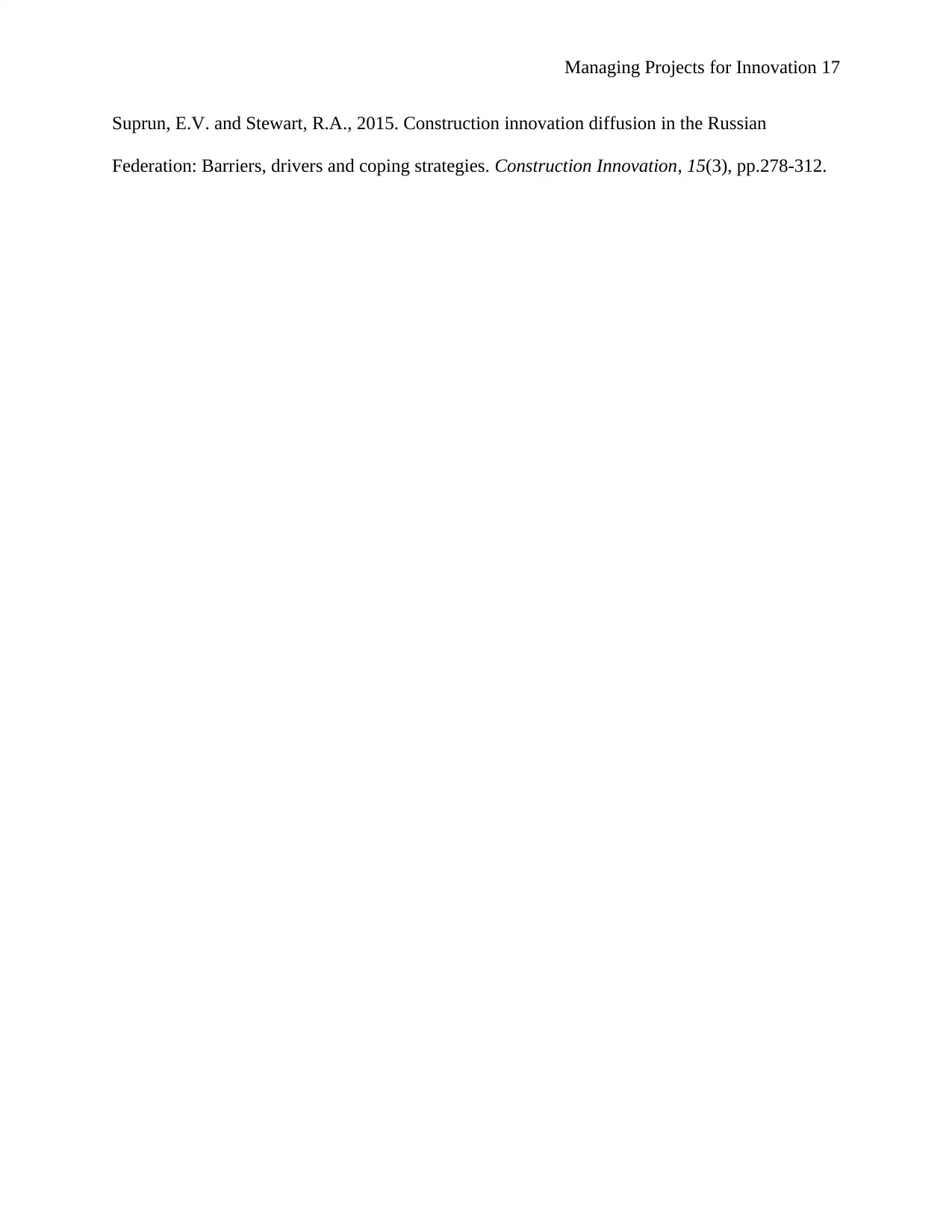
Managing Projects for Innovation 17
Suprun, E.V. and Stewart, R.A., 2015. Construction innovation diffusion in the Russian
Federation: Barriers, drivers and coping strategies. Construction Innovation, 15(3), pp.278-312.
Suprun, E.V. and Stewart, R.A., 2015. Construction innovation diffusion in the Russian
Federation: Barriers, drivers and coping strategies. Construction Innovation, 15(3), pp.278-312.
1 out of 17
Related Documents
Your All-in-One AI-Powered Toolkit for Academic Success.
+13062052269
info@desklib.com
Available 24*7 on WhatsApp / Email
![[object Object]](/_next/static/media/star-bottom.7253800d.svg)
Unlock your academic potential
© 2024 | Zucol Services PVT LTD | All rights reserved.





